Results 6,871 to 6,880 of 12091
Thread: Anandtech News
-
04-18-17, 08:24 AM #6871
Anandtech: The AMD Radeon RX 580 & RX 570 Review: A Second Path to Polaris
Launching today is AMD’s new Radeon RX 500 series. As we’re covering in our companion launch article, the RX 500 series is a refresh of Polaris, bringing about newer, faster SKUs based on the existing Polaris 10 and 11 GPUs. Also joining the family is a newer, smaller GPU, Polaris 12, which will be the basis of the Radeon RX 550. AMD is using an updated revision of Polaris for all of these products, so there are some minor clockspeed improvements and a new memory state that have been baked into the RX 500 family that is not present in the RX 400 family, which makes the new RX 500 parts a bit more interesting.
The first Radeon RX 500 cards out of the gate are the Radeon RX 580 and the Radeon 570, which we’re reviewing today. These SKUs are pretty straightforward: take the new Polaris 10 GPU revision, plug it into more powerful boards, turn up the clockspeeds a bit, and you have a new SKU. AMD hasn’t done anything wild here – the configurations haven’t changed, and in fact TBPs have gone up – so relative to the RX 480 and RX 470, at the end of the day it’s a set of slightly more powerful cards for the same price as before.
More...
-
04-19-17, 01:28 PM #6872
Anandtech: Xiaomi Announces Mi 6: 5.15-inch, Snapdragon 835 SoC, 6GB LPDDR4x
At an event today in Beijing, Xiaomi revealed its latest flagship phone, the Mi 6. Like the Mi 5s it’s replacing, the Mi 6 comes with a 5.15-inch 1080p IPS LCD display and benefits from Xiaomi’s attention to design. The Mi 6 will be sold exclusively in China initially, but will find its way to select global markets at a later date.
Style is just as important to Xiaomi as performance, so it’s no surprise it spent most of the event talking about the Mi 6’s updated design and materials. This generation moves back to edge-to-edge glass on the front and back like the older Mi 5, but the frame is now stainless steel rather than aluminum, which should give it a solid, rigid feel. The sides of the glass back are curved like previous models, but Xiaomi has taken the next step with the Mi 6 by curving the top and bottom edges to match. The curved edges flow smoothly into the polished, rounded metal frame, giving the phone a smooth in-hand feel. The Mi 6 does not use a curved display, but the 2.5D front glass compliments the rounded sides and back.
The standard Mi 6 comes in three different colors: Black with matching black front and sides, White with a white front and silver sides, and Blue with a blue front and gold sides. There are also two special edition models; the Silver color still uses a glass back, but the black model with 18K gold accents comes with a ceramic back. All of the colors are polished and highly reflective (and fingerprint magnets) similar to the HTC U Ultra, which is particularly obvious with the Blue and Silver colors that look like shiny chrome. Matching reflective colors are used on the front too, giving the Mi 6 a cohesive design.
The power button is on the right side just below the single-piece volume rocker, which lines up perfectly with the dual NanoSIM tray on the left side. The USB Type-C port on the bottom supports Qualcomm’s Quick Charge 3.0 fast charging technology and is flanked by a symmetrical series of holes that hide a microphone and a downward-firing speaker. Like the HTC 10, the Mi 6 also uses the earpiece speaker to complement the primary speaker in a pseudo-stereo arrangement. There appears to be an IrLED blaster on the top edge, but you will not find a 3.5mm headphone jack; the Mi 6 joins the growing list of phones omitting the analog port.
The front of the splash resistant but not IP68 rated Mi 6 has relatively large bezels at the top and bottom. The lower bezel has a recessed, non-clickable, pill-shaped fingerprint sensor mounted below the cover glass similar to Huawei’s P10. Xiaomi opted for a balanced look by making the upper bezel the same size as the lower. This design choice also provided enough space to mount the dual rear camera module above the display rather than behind it, allowing Xiaomi to reduce thickness by 0.8 mm to 7.45 mm and increase battery capacity by 5% to 3350 mAh relative to the Mi 5s. The battery boost gives the Mi 6 an advantage over the Huawei P10 (3200 mAh) along with the HTC 10 and Samsung’s Galaxy S7 and S8, all of which come with 3000 mAh batteries and similar sized displays.
The Mi 6’s 5.15-inch 1080p IPS LCD panel reaches a peak brightness of 600 nits, the same as the Mi 5s, according to Xiaomi. It’s not clear, however, if the Mi 6 is also using 16 LEDs in the backlight assembly like the Mi 5s to boost brightness and improve power efficiency, or if it’s using 12 to 14 LEDs like most edge-lit IPS displays of this size. With 4096 brightness levels, instead of the usual 256, display brightness can be adjusted more accurately all the way down to just 1 nit. The extended color gamut panel will show vivid, saturated colors, but Xiaomi generally includes an sRGB mode for people who prefer more accurate colors too.
Packed inside the Mi 6 is Qualcomm’s latest Snapdragon 835 SoC, whose octa-core big.LITTLE CPU configuration uses four semi-custom ARM Cortex-A73 performance cores and four semi-custom Cortex-A53 efficiency cores. In our early testing, it showed a small performance advantage over the Snapdragon 821 SoC in the Mi 5s and Mi 5s Plus when running some common workloads and browser JavaScript benchmarks. There’s also an updated Adreno 540 GPU that delivers around 25% better peak performance on average than the Adreno 530 in the original Mi 5.Xiaomi Mi 6 Xiaomi Mi 5s SoC Qualcomm Snapdragon 835
4x Kryo 280 Performance @ 2.45GHz
4x Kryo 280 Efficiency @ 1.90GHz
Adreno 540 @ 653MHzQualcomm Snapdragon 821
2x Kryo @ 2.15GHz
2x Kryo @ 2.00GHz
Adreno 530 @ 624MHzDisplay 5.15-inch 1920x1080 IPS LCD 5.15-inch 1920x1080 IPS LCD Dimensions 145.2 x 70.5 x 7.45 mm
168 grams / 182 grams (ceramic)145.6 x 70.3 x 8.25 mm
145 gramsRAM 6GB LPDDR4x 3GB / 4GB LPDDR4 NAND 64GB / 128GB (UFS) 64GB / 128GB (UFS) Battery 3350 mAh
non-replaceable3200 mAh
non-replaceableFront Camera 8MP 4MP, 2.0μm, f/2.0 Rear Camera Wide Angle (27mm): 12MP, 1/2.9", 1.25µm pixels, f/1.8, PDAF, 4-axis OIS, HDR, dual-tone LED flash
Zoom (52mm): 12MP, 1.0µm pixels, f/2.612MP, 1/2.3” Sony IMX378 Exmor RS, 1.55µm pixels, f/2.0, PDAF, Auto HDR, dual-tone LED flash Modem Snapdragon X16 LTE (Integrated)
2G / 3G / 4G LTE (Category 16/13)
FDD-LTE / TD-LTE / TD-SCDMA / WCDMA / CDMA / GSMSnapdragon X12 LTE (Integrated)
2G / 3G / 4G LTE (Category 12/13)
FDD-LTE / TD-LTE / TD-SCDMA / WCDMA / CDMA / GSMSIM Size 2x NanoSIM (dual standby) 2x NanoSIM (dual standby) Wireless 802.11a/b/g/n/ac 2x2 MU-MIMO, BT 5.0, NFC, IrLED, GPS/GNSS/Beidou 802.11a/b/g/n/ac 2x2 MU-MIMO, BT 4.2, NFC, GPS/GNSS/Beidou Connectivity USB 2.0 Type-C USB 2.0 Type-C, 3.5mm headset Launch OS Android 7.1.1 with MIUI 8 Android 6.0 with MIUI 8 Launch Price 6GB / 64GB ¥2499
6GB / 128GB ¥2899
6GB / 128GB (ceramic) ¥29993GB / 64GB ¥1999
4GB / 128GB ¥2299
The Mi 6 is one of the first phones to use LPDDR4x RAM, which saves power by using a lower operating voltage than the more common LPDDR4. It pairs the Snapdragon 835 with 6GB of RAM and either 64GB or 128GB of UFS NAND, although there’s no microSD support for supplementing internal storage.
All of the camera hardware is new. Xiaomi did not say much about the 8MP front-facing camera—which improves resolution by a factor of two relative to the 4MP sensor used by the Mi 5 family—but it did offer some details about the new dual rear camera. Unlike the Mi 5s Plus, whose dual rear camera module included both a color and a black-and-white sensor used in tandem to improve image quality, the Mi 6 gives each of its 12MP color sensors a lens with a different focal length to provide different levels of magnification, similar to how the iPhone 7 Plus uses its dual cameras. The primary camera uses a wide-angle lens with a 27mm equivalent focal length, which captures a larger field of view where objects appear smaller than what you see with your naked eye. The secondary camera uses a different 12MP sensor and a 52mm equivalent focal length lens that provides a 2x optical “zoom” where objects appear roughly the same size as they do when viewing them with your eyes. This is not a true zoom lens, however, because any zoom level between 1x and 2x or greater than 2x is still using digital zoom. The two cameras can also be used to create a depth-of-field bokeh effect that blurs the background of photos.
The primary rear camera supports PDAF for faster autofocus performance and comes with the 4-axis OIS system previously seen on the Mi 5, which should improve low-light image quality. An f/1.8 lens, which allows more light to enter the camera, and larger-than-average pixels should also help improve image quality. The secondary camera’s “zoom” lens is slower at f/2.6—a byproduct of its longer focal length—and does not appear to have OIS, which may limit its usefulness in lower-light conditions.
The Mi 6 will be available in China on April 28 at Mi.com and Mi Home stores. The versions with 64GB of storage will cost ¥2499, while the 128GB models will cost ¥2899. The special ceramic edition with 18K gold accents around the rear cameras will cost ¥2999. The larger Mi 6 Plus that was rumored to be launching alongside the Mi 6 did not materialize, however. It’s possible it will be announced in the near future when Xiaomi is ready to expand sales of the Mi 6 to additional markets.
More...
-
04-20-17, 11:07 AM #6873
Anandtech: The Intel Optane SSD DC P4800X (375GB) Review: Testing 3D XPoint Performan
Intel's new 3D XPoint non-volatile memory technology, which has been on the cards publically for the last couple of years, is finally hitting the market as the storage medium for Intel's new flagship enterprise storage platform. The Intel Optane SSD DC P4800X is a PCIe SSD using the standard NVMe protocol, but the use of 3D XPoint memory instead of NAND flash memory allows it to deliver great throughput and much lower access latency than any other NVMe SSD. In this review, we go deep to see if it really works as it should.
More...
-
04-20-17, 11:51 PM #6874
Anandtech: Dell Announces UP2718Q HDR Display, And Two InfinityEdge Displays
Right now, the National Association of Broadcasters conference is on, and Dell is using it to launch their latest UltraSharp display. The Dell UltraSharp UP2718Q is the company’s first display to support HDR10, in addition to its UHD 3840x2160 resolution, and it’s backed by the UHD Alliance Premium Certification.
Dell has been in the UHD display game for some time, and the UltraSharp U2715Q and U2415Q have been solid displays for the company for some time, but the latest model takes Dell to a new level. The UP2718Q offers a very wide color gamut, supporting up to 76.9% of the Rec 2020, and each display comes factory calibrated, and it has an adjustable internal lookup-table as well, so it should be able to be tuned accurately if necessary.
HDR, or High Dynamic Range, requires much brighter backlighting than is typical in a desktop display, and the UP2718Q is stated to hit up to 1000 nits, which is likely helped by full-array backlighting.
This display is targeted directly at professionals, and it has a price tag to go along with that, with availability scheduled for May 23 at $1999.99.
Dell is also launching a couple of other UltraSharp displays, featuring InfinityEdge displays. The U2718Q is a 27-inch UHD model, and the U2515D is a 25-inch model that’s a lower resolution that’s not specified. These are targeted more at the consumer, and won’t support HDR or the wide gamuts. Dell didn’t announce a lot of details on these, but expect sRGB coverage only. The lower feature set drives the price down quite a bit though, with the U2718Q set to be available in July for $699.99, and the U2518D in the same time frame for $499.99.
Dell certainly isn’t alone in the HDR Professional display market, with ASUS and LG both announcing UHD HRD displays recently as well, but Dell has a substantial presence in the enterprise which will likely help them here.
Source: Dell
More...
-
04-21-17, 07:27 AM #6875
Anandtech: Toshiba Launches N300 HDDs for NAS: Up to 8 TB, Up to 240 MB/s
Toshiba this week launched its new lineup of high-reliability hard drives for NAS units. The drives offer up to 8 TB of capacity and are based on enterprise-grade platforms. According to Toshiba's specifications, these and are among the highest-performing 3.5” HDDs on the planet.
The Toshiba N300 family of hard drives consists of three models with 4 TB, 6 TB and 8 TB capacities, a SATA 6 Gb/s interface, a 7200 RPM spindle speed and a 128 MB buffer. All three HDDs are based on a high-reliability platform that attaches a spindle to both sides of a drive (to curb system-induced vibration), has rotational vibration (RV) sensors, shock sensors and temperature sensors as well as supporting error recovery features. The new HDDs are designed for 24/7 availability, 1 million hours MTBF and have a 180 TB/year workload rating, which is in line with other hard drives for NAS devices with 8 bays and is considerably higher than the workload rating of typical desktop HDDs.
Toshiba’s N300 HDDs resemble the company’s MN05-series drives introduced in February (which are also designed for enterprise-class NASes) and are likely based on the same PMR platters (perpendicular magnetic recording) with up to 1.33 TB capacity per platter (the 8 TB version features six of such discs). In addition to the same platters, the N300 drives also have the same power consumption as the MN05 HDDs, but offer slightly different performance, according to the specifications.
As for performance, Toshiba claims up to a 240 MB/s sustained data transfer rate as well as a 4.17 ms average latency time for the N300 8 TB model, which is slower compared to the MN05 8 TB. Meanwhile, since the 6 TB and 4 TB N300 HDDs use different platters, their performance is a bit lower (due to the lower areal density).Toshiba N300-Series HDDs HDWN180XZSTA HDWN160XZSTA HDWQ140XZSTA Capacity 8 TB 6 TB 4 TB RPM 7200 RPM Interface SATA 6 Gbps DRAM Cache 128 MB Data Transfer Speed
(Sustained)240 MB/s 210 MB/s 200 MB/s MTBF 1 million hours Rated Annual Workload (read and write) 180 TB/year Acoustics (Seek) 35 dB 34 dB Power Operating 9.2 W 10.1 W 9.6 W Active Idle 6.2 W 6.7 W 5.2 W Warranty 3 years
Toshiba is already shipping its N300 HDDs to partners and the drives are expected to be available in stores this month. Exact prices will depend on the retailer, but keep in mind that although the N300 are aimed at consumers, they are based on advanced platforms and support numerous enterprise-grade features.
Related Reading:
- Toshiba Announces MN-Series HDDs: Up to 8 TB
- Toshiba Launches MG05ACA Enterprise HDDs: 8 TB, 7200 RPM, NAND Cache
- Seagate Confirms Plans for 12 TB HDD in Near Future, 16 TB HDD Due in 2018
- Western Digital Announces Ultrastar He12 12 TB and 14 TB HDDs
- Promise Launches Pegasus3 External Storage via TB3: Up to 48 TB, 1.6 GBps
More...
-
04-21-17, 08:47 AM #6876
Anandtech: First Look: Samsung Galaxy S8
We first saw Samsung’s new 5.8-inch Galaxy S8 and 6.2-inch Galaxy S8+ at its Unpacked event a few weeks ago. During the event, we saw demos of its new virtual assistant, Bixby, and its DeX docking station, which allows the Galaxy S8 to provide a desktop-like experience by connecting to an external monitor and peripherals, but we didn’t have much time with the phones to do much more than take some pictures and try a couple of the new features. After receiving a Galaxy S8 earlier this week, we wanted to give you some feedback about its design and biometric features, as well as, an initial performance and battery life assessment before we dive into our usual in-depth testing.
My biggest complaint about the design is the location of the fingerprint sensor, which I discuss in the video above. It has been relocated to the back next to the camera, making it difficult to reach and use. The new face unlock feature, the second of the S8’s three biometric authentication options, is flawed too. Despite my best efforts, I was not able to get face unlock to work, not even once. The feature, which relies solely on the front-facing camera for identification, also is not very secure, assuming it works at all. It has already been shown that simply holding a picture in front of the camera is enough to fool it into unlocking the phone. The camera really needs to be augmented with an infrared camera to detect a face’s heat signature as a liveness test, or a second, depth-sensing camera to at least detect a face in three dimensions. So far the iris scanner, which I also demo in the video above, has proven to be the easiest and most reliable biometric option.
Inside the redesigned Galaxy S8 and S8+ is either a Qualcomm Snapdragon 835 or Samsung Exynos 8895 SoC. The US and other regions that require CDMA capability will get the Snapdragon 835, while the rest of the world will get Samsung’s SoC. The new 10nm SoCs are paired with 4GB of LPDDR4 RAM and 64GB of UFS 2.1 NAND. The Galaxy S8 comes with a 3000mAh battery, the same size as the Galaxy S7, while the S8+ comes with a 3500mAh battery, slightly less than the S7 edge’s 3600mAh capacity.Samsung Galaxy S8 Series Samsung Galaxy S8 Samsung Galaxy S8+ SoC Qualcomm Snapdragon 835 (US, China, Japan)
4x Kryo 280 Performance @ 2.35GHz
4x Kryo 280 Efficiency @ 1.90GHz
Adreno 540
Samsung Exynos 8895 (rest of world)
4x Exynos M2 @ 2.30GHz
4x Cortex-A53 @ 1.70GHz
ARM Mali-G71Display 5.8-inch 2960x1440 (18.5:9)
SAMOLED (curved edges)6.2-inch 2960x1440 (18.5:9)
SAMOLED (curved edges)Dimensions 148.9 x 68.1 x 8.0 mm
155 grams159.5 x 73.4 x 8.1 mm
173 gramsRAM 4GB LPDDR4 (US) NAND 64GB (UFS 2.1)
+ microSDBattery 3000 mAh (11.55 Wh)
non-replaceable3500 mAh (13.48 Wh)
non-replaceableFront Camera 8MP, f/1.7, Contrast AF Rear Camera 12MP, 1.4µm pixels, f/1.7, dual-pixel PDAF, OIS, auto HDR, LED flash Modem Snapdragon X16 LTE (Integrated)
2G / 3G / 4G LTE (Category 16/13)
Samsung LTE (Integrated)
2G / 3G / 4G LTE (Category 16/13)SIM Size NanoSIM Wireless 802.11a/b/g/n/ac 2x2 MU-MIMO, BT 5.0 LE, NFC, GPS/Glonass/Galileo/BDS Connectivity USB Type-C, 3.5mm headset Features fingerprint sensor, heart-rate sensor, iris scanner, face unlock, fast charging (Qualcomm QC 2.0 or Adaptive Fast Charging), wireless charging (WPC & PMA), IP68, Mobile HDR Premium Launch OS Android 7.0 with TouchWiz
In PCMark, which is our best indicator of general system performance, the Galaxy S8 with Snapdragon 835 performs quite well, besting even the Mate 9 overall. Because this is the first S835 retail device we’ve tested, I’ve also included Qualcomm’s Snapdragon 835 MDP/S, which the company uses internally for hardware testing and software development, as a reference point. In most of these tests, the Galaxy S8 performs about the same as the Snapdragon 835 MDP/S, which is certainly a good sign.
The Galaxy S8 does particularly well in the Writing test, outscoring the Mate 9 by 13% and the Galaxy S7 (Snapdragon 820) by 85%. The Writing test, which previous Galaxy phones struggle with, uses a fairly bursty workload, frequently migrating threads between the little and big cores. Perhaps this is an indication that Samsung is utilizing the big cores more aggressively than in the past. The Galaxy S8 is also 9% faster than the Mate 9 in the Web Browsing test and 37% faster than the S7 (S820).
The Galaxy S8 achieves over 8 hours of screen-on-time while continuously crunching through the PCMark workloads, 46% longer than the Galaxy S7 that has the same 3000mAh battery, which suggests some nice efficiency gains from the new SoC, display, or other components. While the Galaxy S7 can struggle to last a full day on a single charge depending on how it’s used, these initial results suggest the Galaxy S8 will encounter fewer scenarios where it will need to use its fast charging or wireless charging abilities to stretch battery life till the end of the day.
While we’ve only had the Galaxy S8 for a couple of days, our first impression is generally positive. It’s packed with features, TouchWiz is more refined, and it performed well in our first performance and battery life tests. A few issues are already apparent, however. Your face probably will not be smiling if you try to rely on it to unlock the phone, and the fingerprint sensor is located in just about the worst possible place. Samsung’s Bixby assistant also is not yet fully functional; fortunately, you can still use Google Assistant while you’re waiting for Bixby to mature.
More...
-
04-21-17, 01:29 PM #6877
Anandtech: EIZO Announces ColorEdge Prominence CG3145: 4096x2160, 98% P3 and HDR10
EIZO this week announced its new ColorEdge Prominence CG3145 reference monitor with a DCI-4K resolution and a display covering 98% of the DCI-P3 color space. The monitor is claimed to be designed for professionals working with HDR post-production, particularly for TV and home video industries. The display offers a very high brightness level and contrast ratio, but the key feature of the screen that EIZO mentions is the ability of its IPS panel to display both deep blacks and very bright colors at the same time without artefacts caused by the peculiarities of competing displays.
The EIZO ColorEdge Prominence CG3145 monitor is based on a 10-bit IPS panel that can reproduce 1.07 billion colors and features a 4096×2160 resolution at 60 Hz. The manufacturer says that the display has a 1000 nits typical brightness (as well as a 1,000,000 static contrast ratio). The ColorEdge Prominence CG3145 covers 98% of the DCI-P3, 99% of the Adobe RGB, as well as 80% of the Rec. 2020 color spaces (but these numbers may change as the product is being tuned up now). This comes with a 24-bit 3D LUT (look-up table) for HDR color gradations. As for connectivity, the display will have one DisplayPort capable of DCI-4K with 4:4:4 chroma subsampling at 50/60 Hz, as well as two HDMI 2.0 inputs capable of DCI-4K with 4:2:2 at 50/60 Hz. Since the monitor is aimed primarily at post production video professionals, EIZO has not currently disclosed support of sRGB and also does not disclose specs like response time or power consumption.
The key feature of the ColorEdge Prominence CG3145 display is its ability to properly reproduce both very bright and very dark areas on the scene without artefacts caused by local dimming (used on many IPS-based televisions and on some monitors) or an auto brightness limiter. EIZO does not reveal many details about the IPS panel it uses for the CG3145, but it claims that it has control of backlight intensity in every pixel. The latter means that the company either uses Panasonic’s IPS panels with a special layer of light-modulating cells that enable pixel-by-pixel control of backlight intensity, or a similar technology it has developed in-house.
In both cases, the pixel-by-pixel control of the backlight sets the ColorEdge Prominence CG3145 display apart from the rivals which use IPS panels with local dimming. Another feature that the monitor has is its 24-bit 3D LUT, which has a potential to produce more accurate colors than the 14-bit 3D LUTs supported by other HDR monitors. Speaking of HDR, it is noteworthy that the CG3145 supports both HLG (hybrid log-gamma) and PQ (perceptual quantization) gamma curves. The HLG is suitable for live TV broadcasting as it has a peak luminance of 1000 nits, whereas the PQ supports considerably higher luminance (up to 10,000 nits) and is suitable for recorded content. The combination of these features means that EIZO has positioned the ColorEdge Prominence CG3145 as a reference monitor for HDR content.
EIZO plans to demonstrate the ColorEdge Prominence CG3145 monitor at the NAB Show later this month. Actual sales of the product are going to start sometimes in late 2017 after the manufacturer finalizes all the details and specifications. Given that the display is not going to show up for another six months, EIZO does not talk about its price. EIZO positions the CG3145 as a reference monitor, which are typically priced above professional-grade models.Specifications of the EIZO ColorEdge Prominence Reference HDR Display CG3145 Panel 31.1" IPS Native Resolution 4096 × 2160 Maximum Refresh Rate 60 Hz Response Time unknown Brightness 1000 cd/m² (typical) Contrast '1,000,000:1' Viewing Angles 178°/178° horizontal/vertical HDR HDR10 with 24-bit LUT Dynamic Refresh Rate none Pixel Pitch 0.170 mm² Pixel Density 149 ppi Display Colors 1.07 billion Color Gamut Support DCI-P3: 98%
Adobe RGB: 99%
Rec. 2020: 80%
sRGB: unknownAspect Ratio 1.9:1 Stand to be announced Inputs 1 × DisplayPort
2 × HDMI 2.0a/2.0b (HDCP 2.2)
1 × USB for monitor control and the USB hubUSB Hub 3-port USB 3.0 hub Launch Date Late 2017
Gallery: EIZO Announces ColorEdge Prominence CG3145



Related Reading:
- ASUS ProArt PA32U Display: 4K, 1000 Nits Brightness, 95% DCI-P3, 85% Rec. 2020
- Pre-Orders for LG’s 32UD99 Display Available: 4K, DCI-P3, HDR10, FreeSync for $999
- BenQ Launches the SW320: a 4K Display with HDR for Professionals
- Dell Introduces UltraSharp UP3017 30-Inch Professional Display with 16:10 Aspect Ratio and DCI-P3 Color Space
- Dell’s Ultrasharp 30-inch 4K OLED Now On Sale: UP3017Q for $3500
- Dell’s 32-inch 8K UP3218K Display Now For Sale: Check Your Wallet
- EIZO Launches ColorEdge CG2730 and CS2730 2560×1440 Displays for Professionals and Prosumers
- 16:10 Lives On: EIZO Releases 24-inch ColorEdge CG2420 and CS2420 Professional Monitors
- ASUS Demonstrates ROG Swift PG27UQ: 4K, 144 Hz, HDR, DCI-P3 and G-Sync
More...
-
04-22-17, 09:45 PM #6878
Anandtech: Lenovo Launches 2-in-1 Flex 11 Chromebook: Quad-Core SoC, 4 GB RAM, from $
Lenovo has announced its first 2-in-1 Chromebook designed specifically for consumers. The Flex 11 laptop is powered by an SoC with four ARM cores, features a 360° hinge, a battery that can last for 10 hours and an anti-spill keyboard, a rare feature on inexpensive PCs. The computer will initially ship without the Google Play Store, but the manufacturer promises that Android apps will be coming to the Flex 11 “soon.” Lenovo plans to start selling the new notebook already this month for a price below $300.
Lenovo was not among the first wave Chromebook manufacturers back in 2011, but released its first laptop running Google’s Chrome OS nearly two years later. Since then the company has been gradually expanding its lineup of Chromebooks targeting different audiences. At first, Lenovo only aimed its ThinkPad X131e Chromebook at students in 2013, then it moved on to business users with the ThinkPad Chromebook 13 in mid-2016. Such approach is perfectly logical because students and road warriors use a relatively limited set of applications. With the Flex 11, the company finally releases a Chrome OS-based computer for general consumers, whose needs are very diverse. One of the reasons why Lenovo can target wide audiences with its Chromebooks is because the Chrome OS now supports Android apps and end users can use a wide range of programs they might need. Keep in mind though that there are not a lot of Android applications developed specifically for tablets or 2-in-1s.
Since the Lenovo Flex 11 Chromebook was designed with Android software in mind, it is not surprising that the manufacturer decided to go with the 2-in-1 form-factor and an 11.6” touchscreen display with a 1366×768 resolution. The 360° hinge of the Flex 11 supports four dynamic modes (watch, tent, laptop, and tablet) to better handle different activities. Lenovo claims that the Flex 11 comes in a drop-resistant enclosure made of plastic with an anti-spill keyboard (can handle up to 330 ml of liquid) and “reinforced” ports (whatever that means). The rugged casing made of thick plastic affected dimensions and weight of the Flex 11: it is 21.2 mm thick and weighs 1.35 kilograms, which means that Lenovo traded portability for lower weight, which is logical as the 2-in-1 has a tablet mode (the lower the better).
When it comes to the CPU, the Lenovo Flex 11 is based on an SoC featuring four ARM cores running at 2.1 GHz. The manufacturer does not elaborate which SoC it uses, but since the notebook looks strikingly similar to the N23 Yoga Chromebook quietly launched earlier this year, it is logical to assume that the two computers use the same processor, the MediaTek MT8173C (also found inside the Acer R13). The MT8173 has two ARM Cortex-A72, two ARM Cortex-A53 general-purpose cores, an LPDDR3 memory controller as well as the PowerVR GX6250 (2 clusters) GPU. The chip was originally released in Q1 2015 and today it can be considered as an entry-level solution, something you expect from a sub-$300 computer.
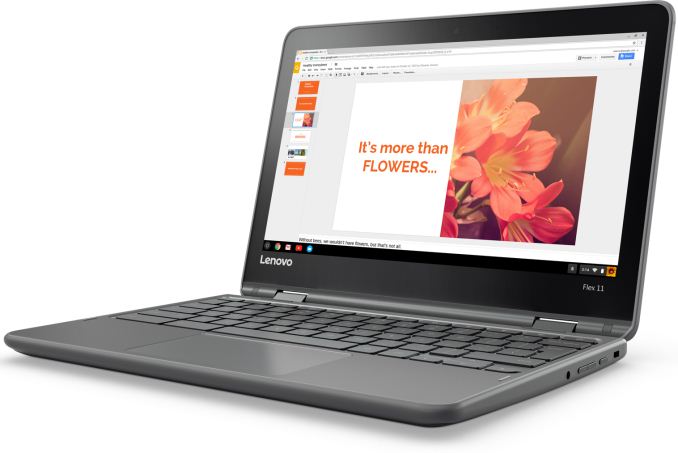
As for other hardware, the Lenovo Flex 11 is equipped with 4 GB of LPDDR3 memory, 32 GB of eMMC storage (it is possible that higher-end model(s) will include more NAND flash), an 802.11ac Wi-Fi module (no word on Bluetooth, but technically the MT8173 supports it) and a 720p webcam. The laptop also features a USB Type-C port for data and charging, a USB 3.0 header, an HDMI output, an SD card reader as well as a TRRS audio connector for headphones and mic.
Lenovo’s Flex 11 Chromebook will hit the shelves later this month and its entry-level configuration will retail for $279. Lenovo did not say when exactly Android apps are coming to the Flex 11, so if you need them, wait till the Chromebook actually gets an appropriate update.Lenovo Flex 11 Chromebook Entry Level Model Screen Resolution 1366×768 CPU MediaTek 8173C (?)
2 × ARM Cortex-A72
2 × ARM Cortex-A53
Note: the SoC is not confirmed by LenovoGraphics ImgTec PowerVR GX6250 RAM 4 GB LPDDR3 Storage 32 GB of eMMC storage Wi-Fi 802.11ac Wi-Fi module Bluetooth unknown USB USB 3.0 Type-A
USB 3.0 Type-CHDMI One HDMI output Other I/O 720p webcam, TRRS connector for audio Dimensions (H × W × D) 296 mm × 206 mm × 21.2 mm
11.65" × 8.11" × 0.83"Weight 1.35 kilograms / 3.0 pounds Price $279
Gallery: Lenovo Flex 11 Chromebook_thumb.png)
_thumb.png)
_thumb.png)
_thumb.png)
_thumb.png)
_thumb.png)
Related Reading:
- New Chrome OS Update Enables Google Play on Acer’s and ASUS' Chromebooks
- Samsung Announces Updated Notebook 9, Odyssey, and Chromebook Plus/Pro
- HP Unveils Premium Chromebook: 3K Display, Intel Core M, 16 GB of RAM and USB-C
- Acer Announces The Rugged Chromebook 11 N7: Designed For Education
- Acer Unveils New Chromebook 14 with Up to 14-Hour Battery Life
More...
-
04-24-17, 09:23 AM #6879
Anandtech: ASUS VivoPC X Console Now Available: Core i5, GeForce GTX 1060 for $799
Word comes that ASUS has begun selling its VivoPC X console-like small form-factor PC in the U.S. As announced back in January, the system features a quad-core processor and a GeForce GTX 1060 GPU is available for $799. Meanwhile, ASUS has teamed up with Amazon and Newegg to offer a bundle consisting of a VivoPC X and an Oculus Rift with Touch starting from $1299; $100 cheaper than their combined retail price when purchased separately.
As previously reported, the ASUS VivoPC X is the company’s entry-level miniature PC designed for gamers who would like to have a gaming machine in their living rooms, but who are not ready to invest in the ROG GR8 II. The machine uses notebook components to give the PC a small form factor, cut down its power consumption, and thus make it relatively quiet. A drawback of such approach is that end-users are unable to upgrade key parts of the system, such as the GPU.
Spec-wise, the ASUS VivoPC X looks to be rather capable for a 5-liter machine (in fact, it carries the Oculus VR Ready label): it is based on the Intel Core i5-7300HQ (4C/4T, 2.5 GHz/3.5 GHz, 6 MB cache, HD Graphics 630, 45 W) CPU, the Intel HM175 PCH, as well as NVIDIA’s GeForce GTX 1060 GPU with 3 GB of GDDR5 memory. As for connectivity, the ASUS VivoPC X has four USB 3.0 Type-A ports, two USB 2.0 headers, Gigabit Ethernet, an IEEE 802.11ac Wi-Fi with BT 4.1 module, three display outputs (two HDMI and one DisplayPort), 5.1-channel audio with Sonic Suite software enhancements, and so on.
The base model that retails for $799 is called the A80CJ-DS51 and comes equipped with 8 GB of DDR4-2400 memory (single-channel) and a 1 TB 2.5” HDD with 5400 RPM spindle speed. Previously, ASUS intended to offer a 512 GB M.2 SATA SSD and a 2 TB 7200 RPM HDD with its VivoPC X; however the company had to cut back a bit on their final specs to hit their $799 price target. At this point the DS51 is the only model available, so we'll have to see if ASUS comes out with any additional versions that are closer to their original specifications. A VivoPC X with an SSD and a faster and more capacious HDD would be a considerably more attractive PC, but it would bring the entry-level SFF gaming system closer to the more expensive ROG GR8 II, muddling the ASUS product lineup.
The ASUS VivoPC X is available from ASUS Store, Amazon, B&H, Fry’s, Microcenter, and Newegg for $799. In addition, from April 25 to June 13, Amazon and Newegg will offer an ASUS VivoPC X and an Oculus Rift with Touch bundles starting at $1299, shaving off $100 off of the price of a complete VR setup.ASUS VivoPC X Specifications A80CJ-DS51 CPU Intel Core i5-7300HQ
Quad Core
2.5 GHz/3.5 GHz
6 MB cache
HD Graphics 630PCH Intel HM175 Graphics NVIDIA GeForce GTX 1060 with 3 GB GDDR5 memory Memory 8 GB of DDR4-2400 (single-channel, single slot) Storage 1 TB 2.5" HDD (5400 RPM) Wi-Fi IEEE 802.11ac Wi-Fi + BT 4.1 Ethernet GbE Display Outputs 2 × HDMI 2.0b
1 × DisplayPortAudio 5.1-channel audio USB 4 × USB 3.0 Type-A (5 Gbps)
2 × USB 2.0 Type-AOther I/O - Dimensions 75.94 mm × 259.8 mm × 279.9 mm
2.99 × 10.23 × 11.02 inchesPSU 230 W OS Windows 10
Gallery: ASUS VivoPC X: Core i5, GeForce GTX 1060, 512 GB SSD, 5-Liter Chassis, $799





Related Reading:
- ASUS VivoPC X: Core i5, GeForce GTX 1060, 512 GB SSD, 5-Liter Chassis, $799
- Calyos NSG Cube: Passively Cooled SFF PC with Intel Core and GeForce GTX 1060
- GIGABYTE's New Console: The 'Gaming GT' PC Launched with Core i7-K, GTX1080, TB3
- Zotac ZBOX MAGNUS EN1080 SFF PC Review: A Premium Gaming Powerhouse
More...
-
04-24-17, 11:14 AM #6880
Anandtech: The Intel Optane Memory (SSD) Preview: 32GB of Kaby Lake Caching
Last week, we took a look at Intel's first product based on their 3D XPoint non-volatile memory technology: the Optane SSD DC P4800X, a record-breaking flagship enterprise SSD. Today Intel launches the first consumer product under the Optane brand: the Intel Optane Memory, a far smaller device with a price that is 20 times cheaper. Despite having "Memory" in its name, this consumer Optane Memory product is not a NVDIMM nor is it in any other way a replacement for DRAM. Instead, it is a very small (16GB or 32GB) but very fast NVMe SSD for use as a cache device in front of slower SATA storage.
More...
Thread Information
Users Browsing this Thread
There are currently 19 users browsing this thread. (0 members and 19 guests)





 Quote
Quote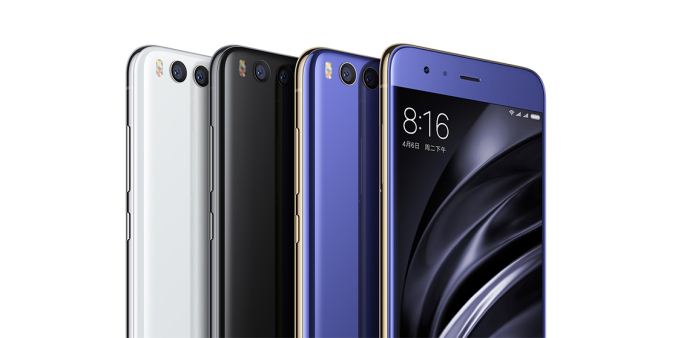

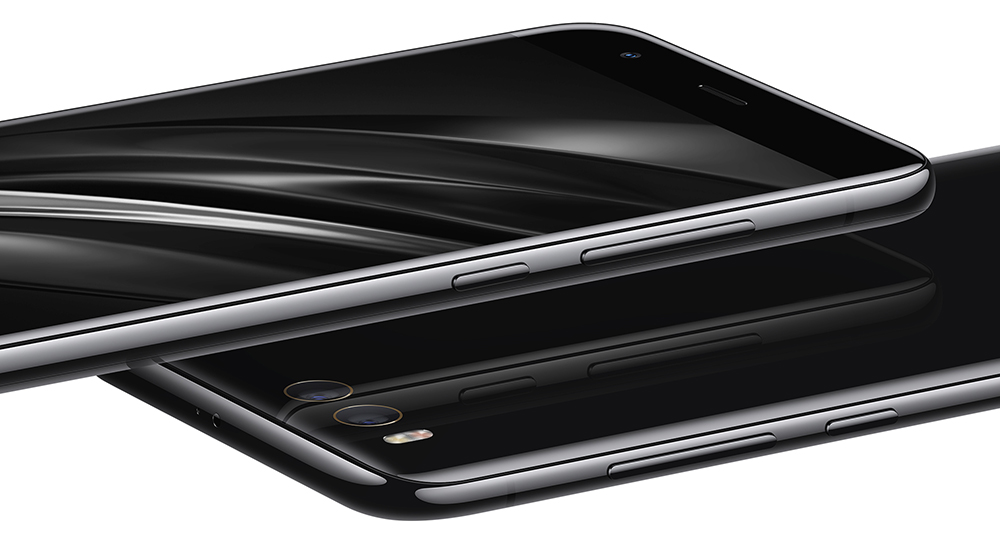
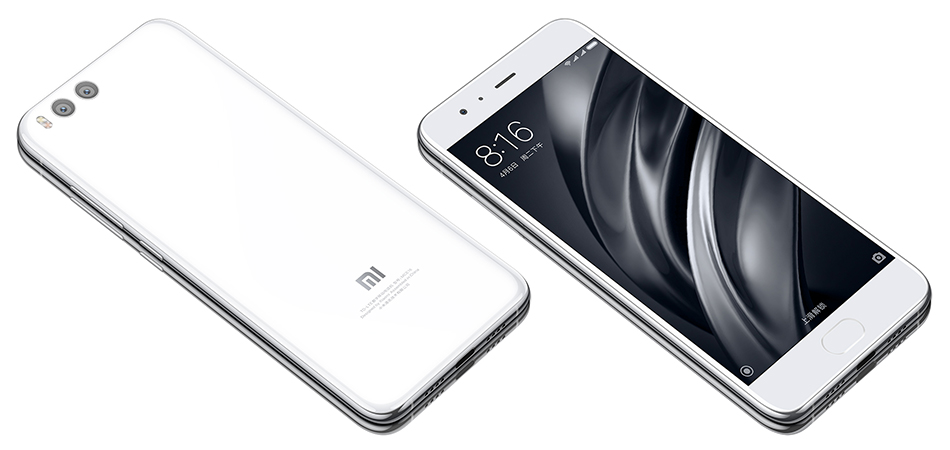
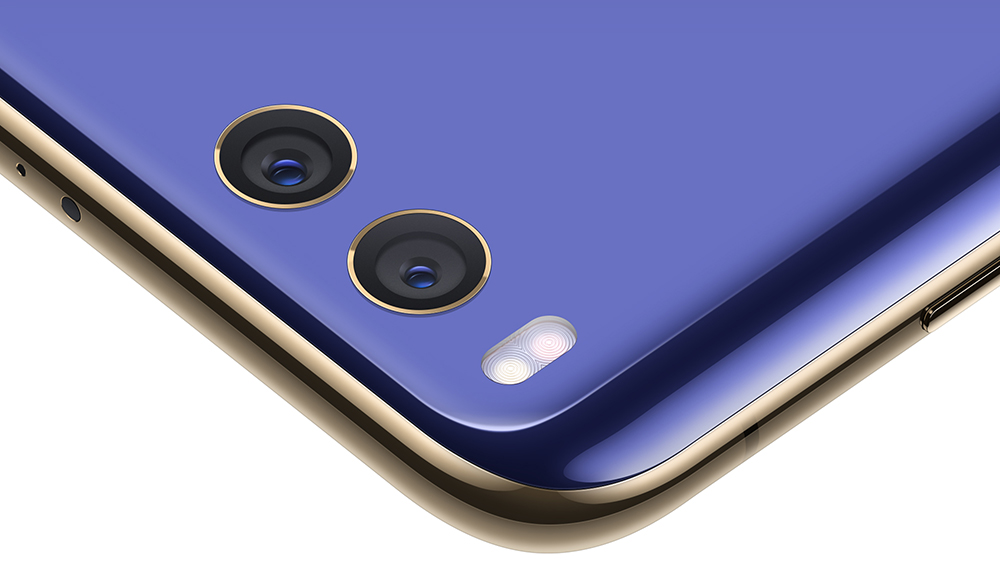
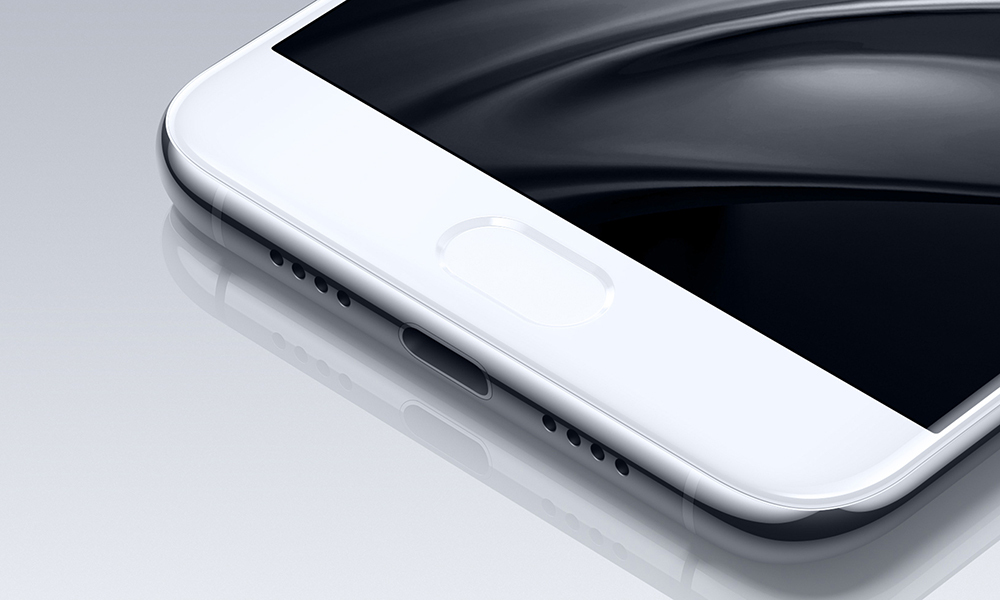
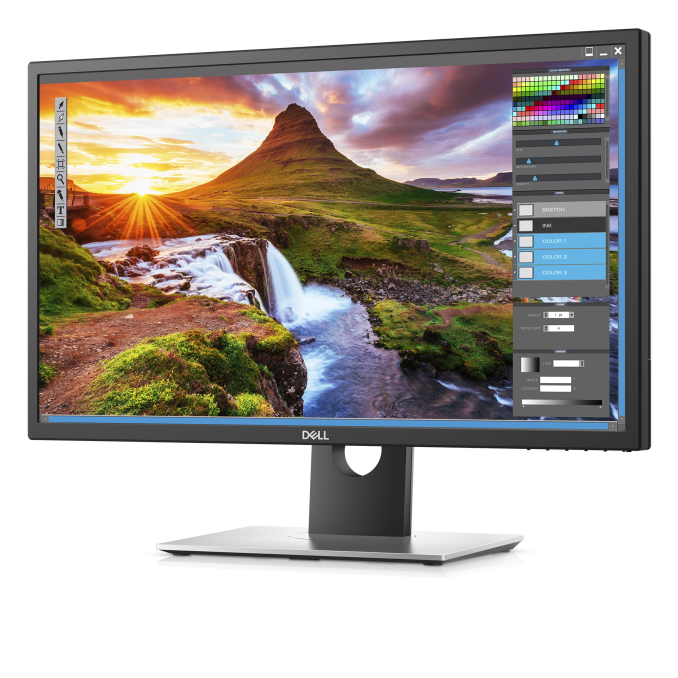
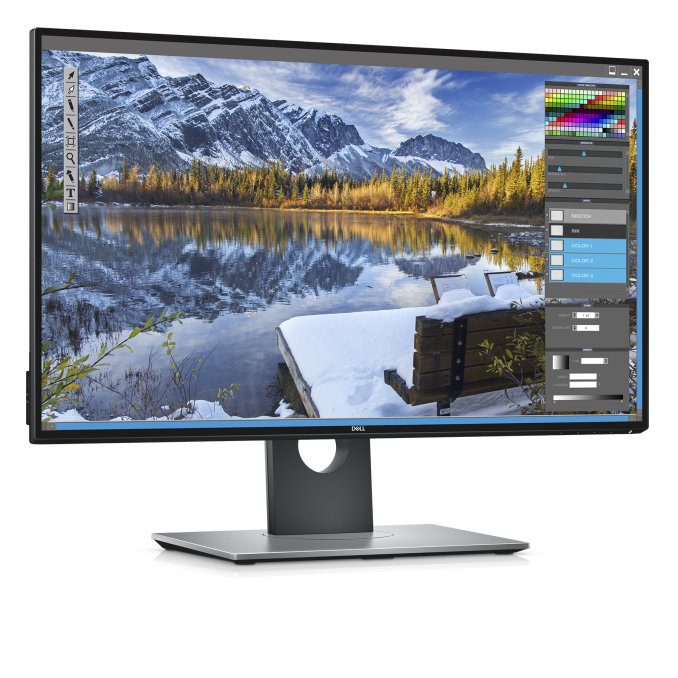

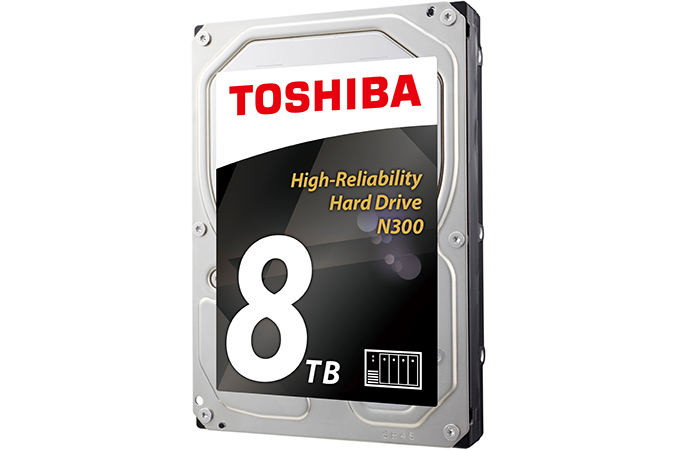
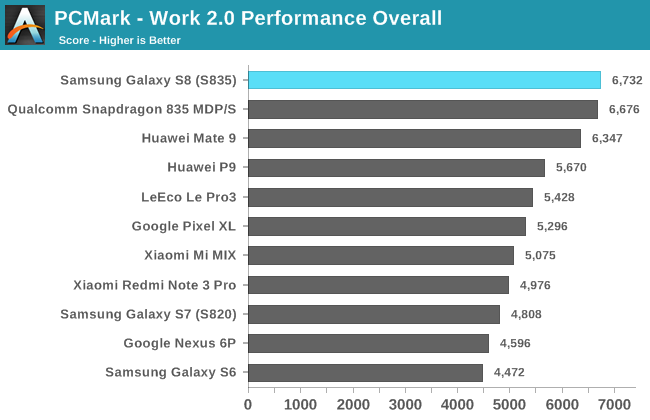
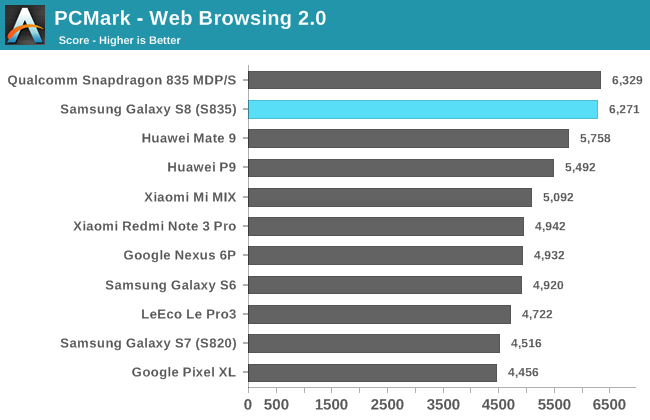
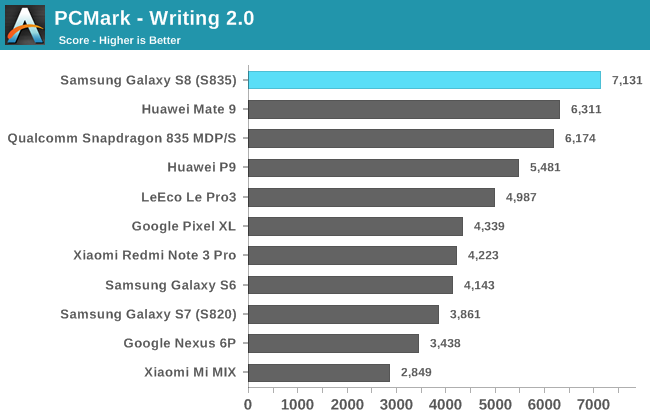
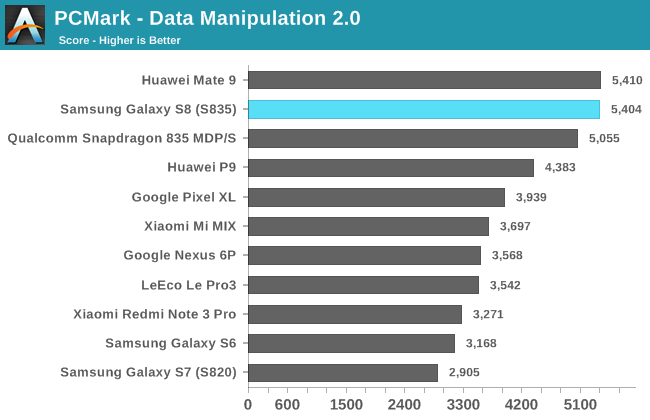
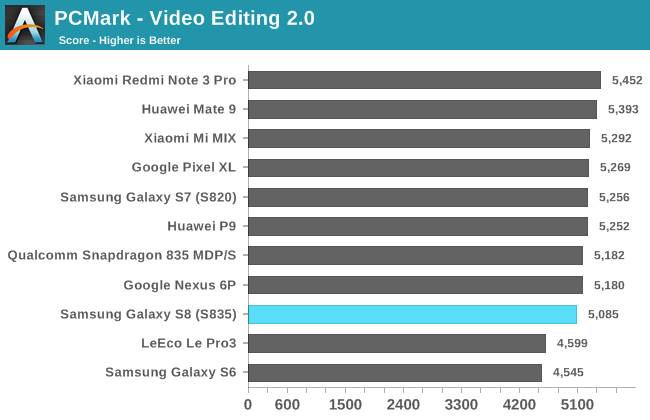
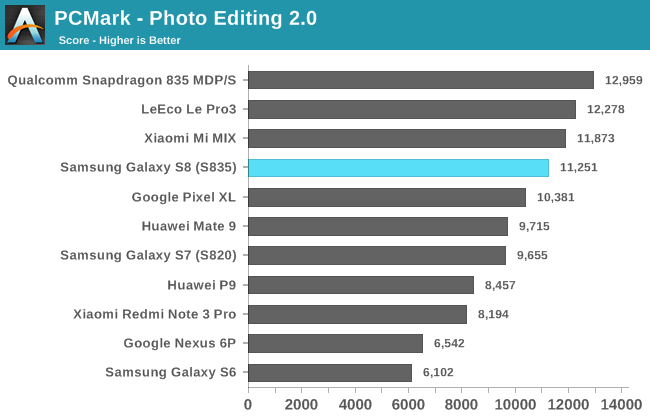

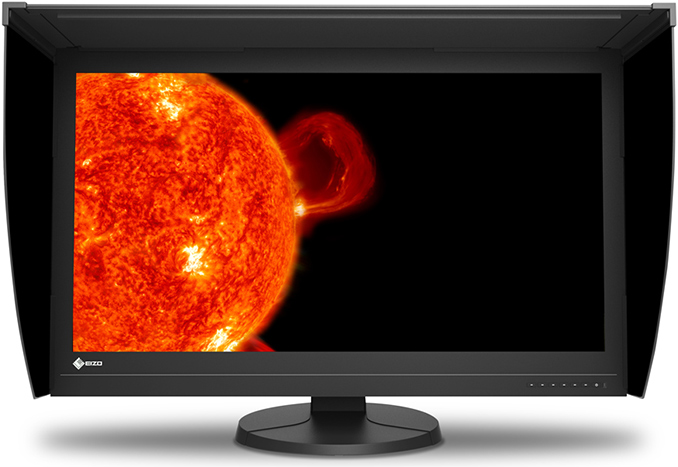
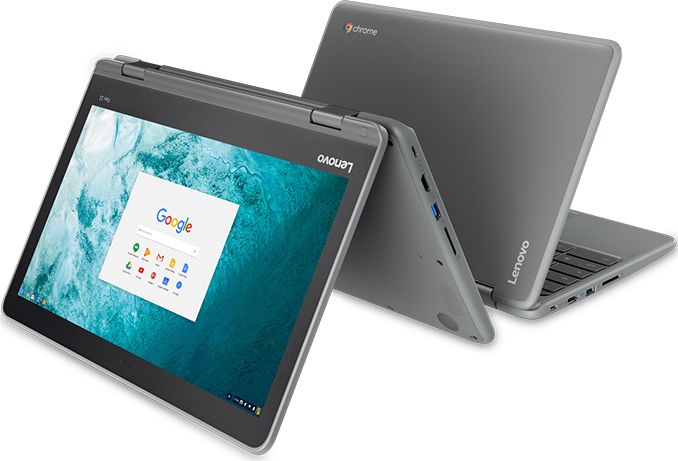
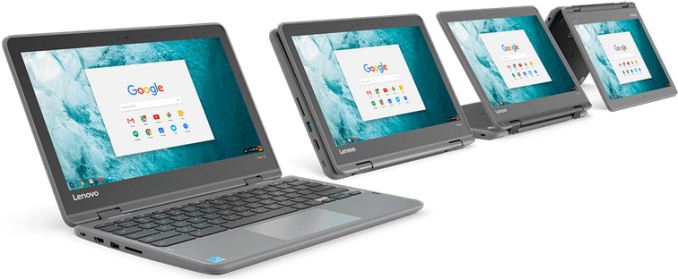


















Bookmarks